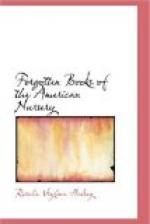The names of Mrs. Anna M. Wells, Mrs. Frances S. Osgood, Mrs. Farrar, Mrs. Eliza L. Follen, and Mrs. Seba Smith were all well beloved by children eighty years ago, and their writings, if long since lost sight of, at least added their quota to the children’s publications which were distinctly American.
If the quantity of books sold is any indication of the popularity of an author’s work, nothing produced by any of these ladies is to be compared with the “Tales of Peter Parley” and the “Rollo Books” of Jacob Abbott.
The tendency to instruct while endeavoring to entertain was remodelled by these men, who in after years had a host of imitators. Great visions of good to children had overtaken dreams of making children good, with the result that William Darton’s conversational method of instruction was compounded with Miss Edgeworth’s educational theories and elaborated after the manner of Hannah More. Samuel Goodrich, at least, confessed that his many tales were the direct result of a conversation with Miss More, whom, because of his admiration for her books, he made an effort to meet when in England in eighteen hundred and twenty-three. While talking with the old lady about her “Shepherd of Salisbury Plain,” the idea came to Mr. Goodrich that he, himself, might write for American children and make good use of her method of introducing much detail in description. As a child he had not found the few toy-books within his reach either amusing or interesting, with the exception of this Englishwoman’s writings. He resolved that the growing generation should be better served, but little dreamed of the unprecedented success, as far as popularity was concerned, that the result of his determination would prove.
After his return to America, the immediate favorable reception of the “Token,” under Goodrich’s direction, led to the publication in the same year (1828) of “Peter Parley’s Tales about America,” followed by “Tales about Europe.” At this date of retrospection the first volume seems in many ways the best of any of the numerous books by the same author. The boy hero, taken as a child companion upon a journey through several states, met with adventures among Indians upon the frontiers, and saw places of historical significance. Every incident is told in imitation of Miss More, with that detailed description which Goodrich had found so fascinating. If a little overdone in this respect, the narrative has certainly a freshness sadly deficient in many later volumes. Even the second tale seems to lack the engaging spontaneity of the first, and already to grow didactic and recitative rather than personal. But both met with an equally generous and appreciative reception. Parley’s educational tales were undoubtedly the American pioneers in what may be readily styled the “travelogue” manner used in later years by Elbridge Brooks and many other writers for little people. These early attempts of Parley’s to educate the young reader were followed by one hundred others, which sold like hot cakes. Of some tales the sales reached a total of fifty thousand in one year, while it is estimated that seven million of Peter Parley’s “Histories” and “Tales” were sold before the admiration of their style and qualities waned.




